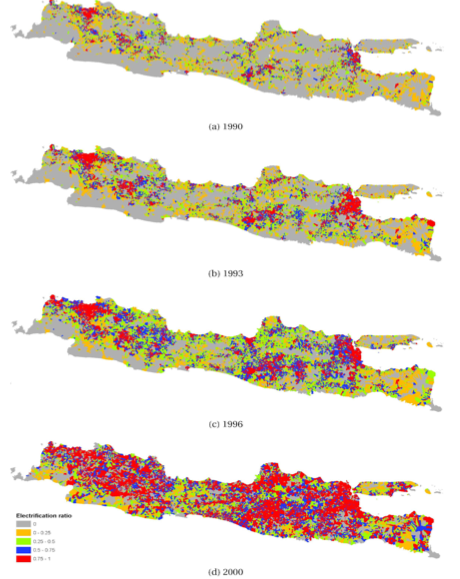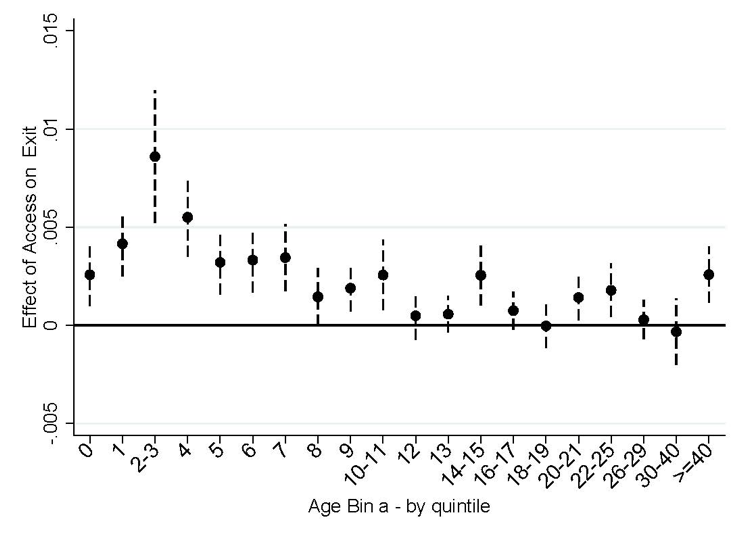Investing in electrification has long been considered an essential ingredient for industrial development, and ultimately growth. In practice, the evidence is mixed, and can vary substantially across different contexts. For example, there is growing evidence that suggests rural electrification does not significantly induce household income growth.1 Given the uncertainty, it is important to understand through which mechanisms electrification can drive economic growth. Rapidly industrializing Indonesia is a good place to look.
Firm Entry and Exit
Matching manufacturing census data to the expansion of the electric transmission grid in Java during the 1990s (Figure 1) gives a particularly rich data source. The study illuminates one important economic mechanism by which electrification drives industrialization firm entry and exit.2 This works as follows:
- Extending the grid to a new location attracts new firms to that particular location.
- Increased competition drives unproductive firms to exit the market.
- Firms of all ages exit more often (Figure 2), suggesting that higher exit is not just driven by a natural churn of new firms trying things out, but instead by electrification actually driving unproductive firms out of the market.
- Over time, firms in electrified locations are on average larger and more productive, and industry-level productivity increases substantially.
Infrastructure Complementarity. The study shows that the impact of electrification on industrial development increases in areas that are already beneficial for businesses. For instance, locations close to roads (and therefore markets), with larger populations, in less mountainous regions, and with some initial basic manufacturing activity benefit more from electrification than areas without these features. This suggests that other infrastructure should be taken into account when planning for high returns on electrification expansion or new roads.
Takeaways
- Pro-competitive policies must allow firm entry. Because firm entry was possible, the effects of electrification on the industrial sector were substantial. Therefore, the benefits from electrification might be negligible without the possibility of entry.
- Extensive barriers to entry can explain insignificant results of electrification. Previous electrification efforts may have failed due to barriers such as substantial transportation costs, credit constraints, or political favoritism.
- Electrification outside the home is the key. Residential electrification can have a limited impact on poverty alleviation, particularly in the short run. But electrification that can create jobs will have an indirect, yet significant, impact on poverty and income growth. While these effects are not immediate, it is essential to consider them when assessing the long-term benefits from electrification.
FIGURE 1: Desa-Level Electrification Ratios in Indonesia 1990-20003

FIGURE 2: Impact of Electrification on Firm Exit by Age of Firm2

Endnotes
- Burlig, Fiona, and Louis Preonas. “Out of the darkness and into the light? Development effects of rural electrification.” Energy Institute at Haas working paper 268 (2016).; Lenz, Luciane, Anicet Munyehirwe, Jörg Peters, and Maximiliane Sievert. “Does large-scale infrastructure investment alleviate poverty? Impacts of Rwanda’s electricity access roll-out program.” World Development 89 (2017): 88-110.; Lee, Kenneth, Edward Miguel, and Catherine Wolfram. (2019). “Experimental Evidence on the Economics of Rural Electrification”, forthcoming Journal of Political Economy.
- Kassem, Dana. Does Electrification Cause Industrial Development? Grid Expansion and Firm Turnover in Indonesia. Working Paper (2020)
- Indonesian Bureau of Statistics. PODES
